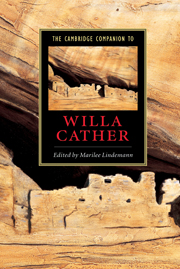Book contents
- Frontmatter
- Introduction
- Part I Contexts and critical issues
- Part II Studies of major works
- 10 Rereading My Ántonia
- 11 Fictions of possession in The Professor’s House
- 12 Catholic expansionism and the politics of depression in Death Comes for the Archbishop
- 13 Willa Cather and “the old story”
- Selected bibliography
- Index
13 - Willa Cather and “the old story”
from Part II - Studies of major works
Published online by Cambridge University Press: 28 May 2006
- Frontmatter
- Introduction
- Part I Contexts and critical issues
- Part II Studies of major works
- 10 Rereading My Ántonia
- 11 Fictions of possession in The Professor’s House
- 12 Catholic expansionism and the politics of depression in Death Comes for the Archbishop
- 13 Willa Cather and “the old story”
- Selected bibliography
- Index
Summary
Sapphira and the Slave Girl (1940), Willa Cather's last novel, is the first to be set in her birthplace, the Shenandoah Valley of northern Virginia. In 1936, just before she began work on this new book, Cather wrote an enthusiastic and reflective essay in response to two of Thomas Mann's biblical novels, based on Old Testament narratives. She praised Mann's skill in “making a new story out of an old one which is a very part of the readers' consciousness,” and concluded, “What we most love is not bizarre invention, but to have the old story brought home to us closer than ever before, enriched by all that the right man could draw from it and, by sympathetic insight, put into it.” This essay appeared in Not Under Forty, a collection that Cather proclaimed was intended for “the backward,” readers “over forty” whose gaze was turned toward the past. Cather herself was now in her early sixties, entering the last decade of a career that had been marked by invention. Each of her eleven novels had posed a fresh set of challenges. As Cather turned to the writing of Sapphira, she confronted at last her own quintessential “old story”: the Virginia of her family history and early childhood.
- Type
- Chapter
- Information
- The Cambridge Companion to Willa Cather , pp. 205 - 221Publisher: Cambridge University PressPrint publication year: 2005
- 2
- Cited by



